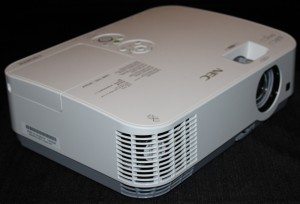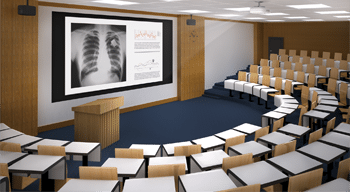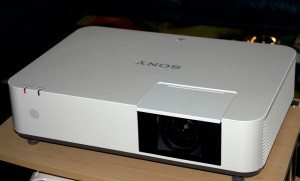Welcome to Projector Reviews 9th annual Best Education Projectors - originally our Best Classroom Projectors report.
This page is designed to touch on a lot of aspects of this report, in order to help you take best advantage of the full report, (and where to find the things you are looking for). For most of you, scanning this and the next page, rather than trying to absorb everything, will make the most sense.
The goal of this Education Projector report remains essentially unchanged which is more about providing insights to what is currently available to schools,
both K-12 and higher education, than attempting to find a single, or several "best" projectors.

NEC's NP-ME331W is an affordable 3LCD, WXGA projector that is especially suitable for conference room and K-12 classrooms
Ultimately, there is no single "best" projector because there is so much variation in what requirements are needed for a particular location, use, and support: Price, resolution, placement flexibility, picture quality, networking, wireless, etc. Every installation has different requirements. We hand out awards to those with superior performance and value for their capabilities.
Does a school need interactive projectors?
What about fairly advanced networking?
Or perhaps cost is the key? Short term costs, or long term?
Important to realize:
The majority of projectors installed in schools prior to the last few years are 4:3 ratio - VGA, SVGA or XGA, many schools want to avoid widescreen projectors (16:10 or 16:9), when replacing older projectors because changing the aspect ratio means new screens and possibly moving the ceiling mount. So, while generally going widescreen (HDTV's 16:9, or business/education 16:10) is desirable from a presenting standpoint, the replacement market is huge, which keeps the sales of 4:3 aspect ratio projectors plenty strong.

Higher Education Classroom/Lecture hall showing DICOM quality medical X-ray
Our objective is to give you a pretty good idea of what's out there in terms of features, capabilities, and options, and why they are important to various users.
Our goal is also to help decision makers figure out which projectors will best server their classrooms, their networking requirements, their auditoriums an special purpose rooms, as well as, when appropriate, which portable projectors work best for those traveling with a projector, whether from room to room, or perhaps a specialty instructor that travels from school to school, or a professor that prefers to carry "his own" when visiting other institutions.
We wish to thank Epson America for sponsoring this year's Education Report.
Welcome to Projector Reviews 9th annual Best Education Projectors - originally our Best Classroom Projectors report.
This page is designed to touch on a lot of aspects of this report, in order to help you take best advantage of the full report, (and where to find the things you are looking for). For most of you, scanning this and the next page, rather than trying to absorb everything, will make the most sense.
The goal of this Education Projector report remains essentially unchanged which is more about providing insights to what is currently available to schools, both K-12 and higher education, than attempting to find a single, or several "best" projectors.

NEC's NP-ME331W is an affordable 3LCD, WXGA projector that is especially suitable for conference room and K-12 classrooms
Ultimately, there is no single "best" projector because there is so much variation in what requirements are needed for a particular location, use, and support: Price, resolution, placement flexibility, picture quality, networking, wireless, etc. Every installation has different requirements. We hand out awards to those with superior performance and value for their capabilities.
Does a school need interactive projectors?
What about fairly advanced networking?
Or perhaps cost is the key? Short term costs, or long term?
Important to realize: The majority of projectors installed in schools prior to the last few years are 4:3 ratio - VGA, SVGA or XGA, many schools want to avoid widescreen projectors (16:10 or 16:9), when replacing older projectors because changing the aspect ratio means new screens and possibly moving the ceiling mount. So, while generally going widescreen (HDTV's 16:9, or business/education 16:10) is desirable from a presenting standpoint, the replacement market is huge, which keeps the sales of 4:3 aspect ratio projectors plenty strong.

Higher Education Classroom/Lecture hall showing DICOM quality medical X-ray
Our objective is to give you a pretty good idea of what's out there in terms of features, capabilities, and options, and why they are important to various users.
Our goal is also to help decision makers figure out which projectors will best server their classrooms, their networking requirements, their auditoriums an special purpose rooms, as well as, when appropriate, which portable projectors work best for those traveling with a projector, whether from room to room, or perhaps a specialty instructor that travels from school to school, or a professor that prefers to carry "his own" when visiting other institutions.
We wish to thank Epson America for sponsoring this year's Education Report.




